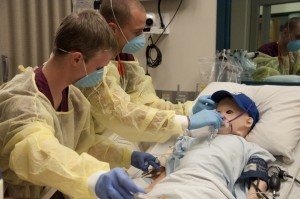
The college’s fourth annual Healthcare Simulation Conference, held Sept. 16-17, featured four faculty members from the Harvard University Center for Medical Simulation. This conference is one of two important events in the college’s Nursing department.
Jenny Rudolph, Ph.D., Dan Raemer, Ph.D., Robert Simon, Ed.D., and Walter Eppich, MD, ME.d, from the Center for Medical Simulation, Harvard University, were featured presenters at the fourth annual conference. The conference, “Playing Seriously: Simulation in Healthcare,” was held in the Regnier Center’s Capitol Federal Conference Center.
Jeanne Walsh, Director of Nursing, said there was a focus on the different methods of debriefing – analyzing how the students have performed during the simulation.
“We need to look at what methods of debriefing work best,” Walsh said.
The conference highlighted the Harvard style of debriefing. Walsh said it was a good addendum to the debriefing style already in place.
“We are fortunate to have (the Harvard faculty members),” Walsh said. “Simulation, I think, is the answer to nurse preparedness.”
Kathy Carver, Zamierowski Family endowed professor of Nursing, said simulation was a critical part of teaching the program.
“Simulators provide the whole experience for students – what they see, hear, feel, how they use their knowledge,” Carver said.
Nursing Student David Munyan said simulation was a very useful aspect of the program.
“Simulation puts us in control of the environment,” Munyan said.
Additionally, JCCC is one of 10 colleges across the United States to be selected for a study by the National Council of State Boards of Nursing. The study aims at discovering how many hours of simulation make a difference to training. Walsh said the study would provide needed data that would benefit a wide range of healthcare spheres.
“This is a groundbreaking, landmark research,” Walsh said. “We are so proud to be a part of it.”
Carver said all healthcare programs would look at the outcome of this research.
“Can we train better? How much can we say simulation is as valuable as clinicals? This is what this study is about,” said Carver.
The college’s inclusion in this study is in part due to the institution’s history of simulation. The college acquired its first simulator mannequin in 2001. In 2008, the Healthcare Simulation Center was dedicated, housing 14 simulators. The simulators include seven adults, two birthing mothers, three newborns and two six-year olds. Carver said that a variety of students use the Healthcare Simulation Center.
“It is mainly used by Nursing, EMS and Respiratory Care students,” Carver said. “We also offer other programs, such as RN refresher courses, for those already in the profession and health career students from visiting high schools.”
The Healthcare Simulation Center stays at the edge of technology to ensure the best experience for the students. Carver said that simulators acted like real humans to a very high degree.
“They are more than just mannequins,” Carver said. “They are simulators full of computers. Their eyes react to light. They react to real oxygen administration, they have a pulse – they even have a voice.”
For more information about the Healthcare Simulation Center, go to http://www.jccc.edu/healthcaresimulation.
Contact Rachel Luchmun, reporting correspondent, at [email protected].





















